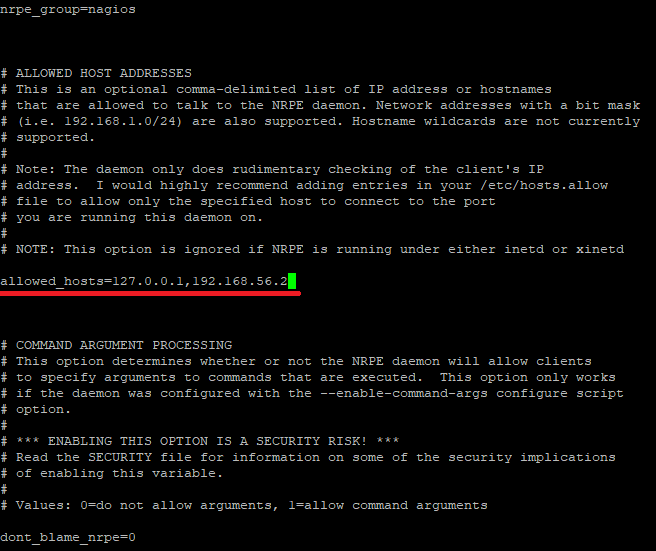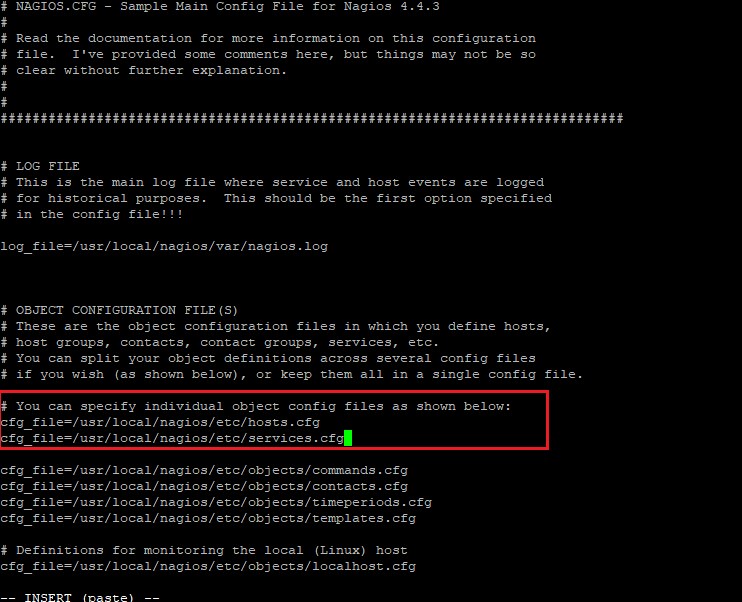Configure Nagios to Monitor Remote Windows Host
To configure Nagios to monitor a remote Windows host, you’ll need to set up NSClient++ on the Windows Machine. Install Nagios on the ... Read More
Learn more about why Eclipsys has been named the 2023 Best Workplaces in Technology and Ontario, Certified as a Great Place to Work in Canada and named Canada’s Top SME Employer!
Learn more!To monitor a remote Oracle Linux host using Nagios, we’ll need to install Nagios Plugins and NRPE (Nagios Remote Plugin Executor) on the remote host.
NRPE is a Nagios agent that allows remote systems to execute Nagios plugins on them. It facilitates the monitoring of local resources and services on remote hosts. NRPE can be installed on various operating systems, including Linux and Windows.
To monitor the remote Linux host we must install NRPE and Nagios Plugin, here are the steps:
1. First let’s check my Linux version
[root@src ~]# more /etc/*release; :::::::::::::: /etc/oracle-release :::::::::::::: Oracle Linux Server release 7.9
2. Install Required Packages
2_1. Configuring the YUM repository, I copied Linux 7 on my host in /software path.
[root@src ~]# more /etc/yum.repos.d/oracle-linux-ol7.repo [ol7_latest] name=Oracle Linux $releasever Latest ($basearch) baseurl=file:///software/linux7 gpgkey=file:///etc/pki/rpm-gpg/RPM-GPG-KEY-oracle gpgcheck=0 enabled=1 [root@src linux7]# yum update
2_2. Then install the following packages.
[root@src linux7]# yum install -y gcc glibc glibc-common gd gd-devel make net-snmp openssl-devel tar wget
2_3. Create Nagios user
[root@src linux7]# useradd nagios [root@src linux7]# passwd nagios Changing password for user nagios. New password: Retype new password: passwd: all authentication tokens updated successfully.
2_4. Create the directory for Nagios Plugin and download the package in this directory
[root@src linux7]# mkdir /root/nagios [root@src linux7]# cd /root/nagios [root@src linux7]# wget https://nagios-plugins.org/download/nagios-plugins-2.3.3.tar.gz
[root@src nagios]# tar -xvf nagios-plugins-2.3.3.tar.gz [root@src nagios]# ls -l total 2724 drwxr-xr-x 15 root root 4096 Mar 11 2020 nagios-plugins-2.3.3 -rw-r--r-- 1 root root 2782610 Dec 15 16:36 nagios-plugins-2.3.3.tar.gz [root@src nagios]# cd nagios-plugins-2.3.3 [root@src nagios-plugins-2.3.3]# ./configure [root@src nagios-plugins-2.3.3]# make [root@src nagios-plugins-2.3.3]# make install ##Set the permissions on the plugin directory using the chown command. [root@src nagios-plugins-2.3.3]# chown nagios.nagios /usr/local/nagios [root@src nagios-plugins-2.3.3]# chown -R nagios.nagios /usr/local/nagios/libexec
[root@src nagios]# cd /root/nagios [root@src nagios]# wget https://github.com/NagiosEnterprises/nrpe/releases/download/nrpe-4.0.2/nrpe-4.0.2.tar.gz [root@src nagios]# tar xzf nrpe-4.0.2.tar.gz [root@src nagios]# cd nrpe-4.0.2 [root@src nrpe-4.0.2]# ./configure [root@src nrpe-4.0.2]# make all cd ./src/; make make[1]: Entering directory `/root/nagios/nrpe-4.0.2/src' gcc -g -O2 -I/usr/include/krb5 -DHAVE_CONFIG_H -I ../include -I ./../include -o nrpe ./nrpe.c ./utils.c ./acl.c -lssl -lcrypto -lnsl gcc -g -O2 -I/usr/include/krb5 -DHAVE_CONFIG_H -I ../include -I ./../include -o check_nrpe ./check_nrpe.c ./utils.c -lssl -lcrypto -lnsl make[1]: Leaving directory `/root/nagios/nrpe-4.0.2/src' *** Compile finished *** You can now continue with the installation or upgrade process. Read the PDF documentation (docs/NRPE.pdf) for information on the next steps you should take to complete the installation or upgrade. [root@src nrpe-4.0.2]# make install-plugin cd ./src/; make install-plugin make[1]: Entering directory `/root/nagios/nrpe-4.0.2/src' /usr/bin/install -c -m 755 -d /usr/local/nagios/bin /usr/bin/install -c -m 755 ../uninstall /usr/local/nagios/bin/nrpe-uninstall /usr/bin/install -c -m 775 -o nagios -g nagios -d /usr/local/nagios/libexec /usr/bin/install -c -m 775 -o nagios -g nagios -d /usr/local/nagios/libexec /usr/bin/install -c -m 775 -o nagios -g nagios check_nrpe /usr/local/nagios/libexec make[1]: Leaving directory `/root/nagios/nrpe-4.0.2/src' [root@src nrpe-4.0.2]# make install-daemon cd ./src/; make install-daemon make[1]: Entering directory `/root/nagios/nrpe-4.0.2/src' /usr/bin/install -c -m 755 -d /usr/local/nagios/bin /usr/bin/install -c -m 755 ../uninstall /usr/local/nagios/bin/nrpe-uninstall /usr/bin/install -c -m 755 nrpe /usr/local/nagios/bin /usr/bin/install -c -m 755 -o nagios -g nagios -d /usr/local/nagios/var /usr/bin/install -c -m 755 -d /usr/lib/tmpfiles.d /usr/bin/install -c -m 644 ../startup/tmpfile.conf /usr/lib/tmpfiles.d/nrpe.conf make[1]: Leaving directory `/root/nagios/nrpe-4.0.2/src' [root@src nrpe-4.0.2]# make install-config /usr/bin/install -c -m 775 -o nagios -g nagios -d /usr/local/nagios/etc /usr/bin/install -c -m 644 -o nagios -g nagios sample-config/nrpe.cfg /usr/local/nagios/etc [root@src nrpe-4.0.2]# make install-init /usr/bin/install -c -m 644 startup/default-service /usr/lib/systemd/system/nrpe.service

4_1. Now open /usr/local/nagios/etc/nrpe.cfg file and add the local host and IP address of the Nagios Monitoring Server.
[root@src nrpe-4.0.2]# vi /usr/local/nagios/etc/nrpe.cfg allowed_hosts=127.0.0.1,192.168.56.2

4_2. Restart NRPE:
[root@src nrpe-4.0.2]# systemctl enable nrpe Created symlink from /etc/systemd/system/multi-user.target.wants/nrpe.service to /usr/lib/systemd/system/nrpe.service. [root@src nrpe-4.0.2]# systemctl restart nrpe

4_3. Open NRPE Port in Firewall (I disabled the firewall in my Linux)
If a firewall is enabled on your Nagios server, you must allow traffic on the NRPE port (default is 5666). Update your firewall rules accordingly.
# firewall-cmd --zone=public --add-port=5666/tcp # firewall-cmd --zone=public --add-port=5666/tcp --permanent
In my case firewall is disabled
[root@src nrpe-4.0.2]# systemctl status firewalld
● firewalld.service - firewalld - dynamic firewall daemon
Loaded: loaded (/usr/lib/systemd/system/firewalld.service; disabled; vendor preset: enabled)
Active: inactive (dead)
Docs: man:firewalld(1)
Run the following netstat command to verify the NRPE daemon working correctly.
[root@src nrpe-4.0.2]# netstat -na | grep "5666" tcp 0 0 0.0.0.0:5666 0.0.0.0:* LISTEN tcp6 0 0 :::5666 :::* LISTEN ##verify the NRPE daemon is functioning properly by running the “check_nrpe” command that was installed earlier for testing purposes. [root@src nrpe-4.0.2]# /usr/local/nagios/libexec/check_nrpe -H 127.0.0.1 NRPE v4.0.2

we had installed NRPE On the Nagios Monitoring Server in the previous article: Install Nagios Core on Oracle Linux 8.5 (OL8.5)
1. Verify NRPE Daemon Remotely
connect to the Nagios Server
# /usr/local/nagios/libexec/check_nrpe -H <remote_linux_ip_address> [root@emcl libexec]# /usr/local/nagios/libexec/check_nrpe -H 192.168.56.10 -bash: /usr/local/nagios/libexec/check_nrpe: No such file or directory # I checkedm, I the package source that I download for the Nagios server shit file was missing, therefore, I copied it from the remote host. [root@emcl libexec]# ll | wc -l 63 ##on the client [root@src libexec]# ll | wc -l 64 [root@src ~]# scp /usr/local/nagios/libexec/check_nrpe root@192.168.56.2://usr/local/nagios/libexec/ The authenticity of host '192.168.56.2 (192.168.56.2)' can't be established. ECDSA key fingerprint is SHA256:A8Z6mVuYWIrJWJkMuDJ7qiGkLHBBWvmcRbMQuoM2ZNM. ECDSA key fingerprint is MD5:7b:35:06:3e:fe:43:90:7d:c6:a8:0a:00:2c:01:72:b5. Are you sure you want to continue connecting (yes/no)? yes Warning: Permanently added '192.168.56.2' (ECDSA) to the list of known hosts. root@192.168.56.2's password: check_nrpe ###Now, it is working on the server on server [root@emcl libexec]# /usr/local/nagios/libexec/check_nrpe -H 192.168.56.10 NRPE v4.0.2
2. Adding the following information in nagios.cfg file


3. Configuring Nagios Host, Services, and Command Files
3_1. Configuring Host file
## Default Linux Host Template ## define host{ name linux-box ; Name of this template use generic-host ; Inherit default values check_period 24x7 check_interval 5 retry_interval 1 max_check_attempts 10 check_command check-host-alive notification_period 24x7 notification_interval 30 notification_options d,r contact_groups admins register 0 ; DONT REGISTER THIS - ITS A TEMPLATE } ## Default define host{ use linux-box ; Inherit default values from a template host_name src ; The name we're giving to this server alias Oracle Linux Server release 7.9 ; A longer name for the server address 192.168.56.10 ; IP address of Remote Linux host }
3_2. Configuring services.cfg file
define service{
use generic-service
host_name src
service_description CPU Load
check_command check_nrpe!check_load
}
define service{
use generic-service
host_name src
service_description Total Processes
check_command check_nrpe!check_total_procs
}
define service{
use generic-service
host_name src
service_description Current Users
check_command check_nrpe!check_users
}
define service{
use generic-service
host_name src
service_description SSH Monitoring
check_command check_nrpe!check_ssh
}
define service{
use generic-service
host_name src
service_description FTP Monitoring
check_command check_nrpe!check_ftp
}
3_3. Configuring NRPE Command Definition file
# vi /usr/local/nagios/etc/objects/commands.cfg
###add following to the end of the file
define command{
command_name check_nrpe
command_line $USER1$/check_nrpe -H $HOSTADDRESS$ -c $ARG1$
}
3_4. Checking the configuration is done correctly
[root@emcl etc]# /usr/local/nagios/bin/nagios -v /usr/local/nagios/etc/nagios.cfg

3_5. Restart the Nagios service on the Nagios server
[root@emcl etc]# systemctl restart nagios

To configure Nagios to monitor a remote Windows host, you’ll need to set up NSClient++ on the Windows Machine. Install Nagios on the ... Read More
Monitoring the Oracle Database with Nagios involves using plugins and configurations that allow Nagios to check the status and performance of the ... Read More